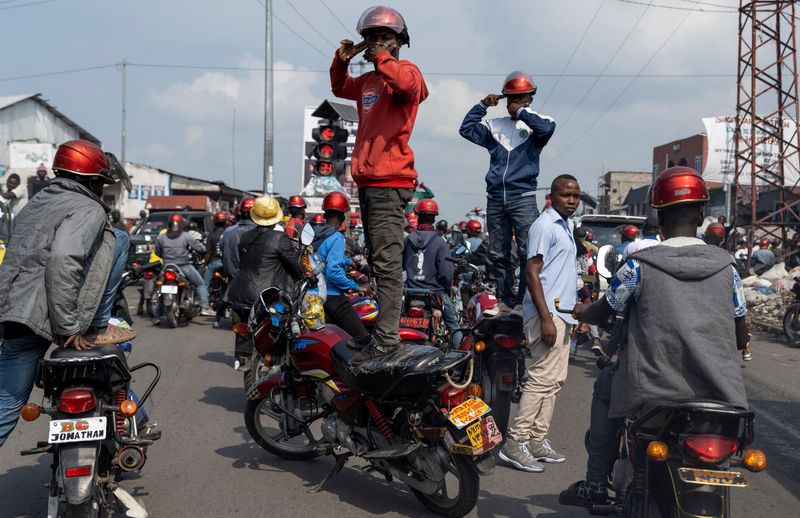
©Reuters. Activists gesture as they march during a demonstration calling for an end to the fighting between M23 rebels and the Congolese army and denouncing the international community’s silence on the conflicts in Goma, North Kivu province of the Democratic Republic
By Ange Kasongo
KINSHASA (Reuters) – Violent clashes have intensified between the Democratic Republic of Congo (DRC) army and Rwanda-backed Tutsi-led M23 rebels in eastern Congo, killing dozens of people and displacing hundreds of thousands.
The fighting, in a decades-long war, has raised the risk of an all-out conflict between Congo and Rwanda that could suck in neighbors and regional forces including South Africa, Burundi, Uganda, Tanzania and Malawi.
In the capital Kinshasa and the capital of North Kivu province, Goma, Congolese took to the streets to protest against the deterioration of security in the east and accused the international community of not doing enough to hold Rwanda to account for its support for the rebels .
WHAT IS THE M23?
The M23, which refers to the March 23 date of a 2009 agreement that ended an earlier Tutsi-led uprising in eastern Congo, is the latest in a series of ethnic Tutsi rebel groups that have risen up against the Congolese forces.
The group accused Congo’s government of failing to live up to the peace agreement aimed at fully integrating Congolese Tutsis into the army and administration. It also promises to defend Tutsi interests, particularly against ethnic Hutu militias such as the Democratic Forces for the Liberation of Rwanda (FDLR), founded by Hutus who fled Rwanda after participating in the 1994 genocide of more than 800,000 Tutsis and moderate Hutus.
The rebels have moved closer to Goma in recent weeks and are now stationed in the hills outside Sake, 25km from Goma, after blocking main roads north and west of the city. The capture of Goma would represent the largest military gain in a decade.
WHAT DID THE LATEST RIOT DO?
In 2012 and 2013, the M23 conquered much of eastern Congo and entered Goma, a strategic economic hub, before being driven out by Congolese and UN forces in Uganda and Rwanda.
In March 2022, the group launched a series of attacks and seized large areas of eastern Congo, saying the move was a defensive response to attacks by the FDLR, which they said were collaborating with the Congolese army. The Congolese army has denied collaborating with the FDLR.
HOW AND WHY IS RWANDA INVOLVED?
Congo’s government, United Nations officials and Western powers, including the United States and Belgium, have accused Rwanda of providing support to the M23, including weapons and soldiers, despite Rwanda’s repeated denials.
Rwanda and Uganda have a long history of military interventions in Congo. The two countries invaded the territory in 1996 and 1998, claiming they were defending themselves from local militia groups.
The United States has urged Rwanda to withdraw its military personnel from Congo and remove its surface-to-air missile systems.
Rwanda blamed the escalation on Congo’s decision to end the mandate of regional peacekeepers. He added that his actions were taken due to threats to Rwanda’s national security, including statements by Congolese officials threatening to invade Rwanda.
REGIONAL FORCES INVOLVED
Fighting continued despite several ceasefires brokered by regional leaders and the United States in 2022 and 2023. Frustrated by the ineffectiveness of regional troops, particularly Kenya, deployed to force the rebels’ withdrawal, Congo decided to ending the regional force’s mandate, leading to its withdrawal in December.
In May, the 16-member Southern African Development Community (SADC) approved a military mission for eastern Congo to help the country deal with instability and counter armed groups.
Unlike East African forces, SADC troops, which include forces from South Africa, Malawi and Tanzania, have an offensive mandate to support Congo’s army in the fight against rebel groups.
South Africa has said it will contribute 2,900 troops. It reported that two of its soldiers were killed and three wounded by a mortar in eastern Congo.